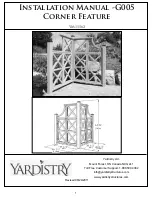
5
Procedure for installing the thru-hull mount
transducer
1. With the boat hauled out of the water, mark the location se-
lected for mounting the transducer on the bottom of the hull.
2. If the hull is not level within 15
°
in any direction, fairing blocks
made out of teak should be used between the transducer and
hull, both inside and outside, to keep the transducer face paral-
lel with the water line. Fabricate the fairing block as shown
below and make the entire surface as smooth as possible to
provide an undisturbed flow of water around the transducer.
The fairing block should be smaller than the transducer itself
to provide a channel to divert turbulent water around the sides
of the transducer rather than over its face.
Upper
half
Lower
half
Hole for
stuffing tube
BOW
Saw along slope of hull.
Figure 1-7 Construction of fairing block
3. Drill a hole just large enough to pass the threaded stuffing tube
of the transducer through the hull, making sure it is drilled ver-
tically.
4. Apply a sufficient amount of high quality caulking compound
to the top surface of the transducer, around the threads of the
stuffing tube and inside the mounting hole (and fairing blocks
if used) to ensure watertight mounting.
5. Mount the transducer and fairing blocks and tighten the lock-
ing nuts. Be sure that the transducer is properly oriented and its
working face is parallel to the waterline.
Note: Do not over-stress the stuffing tube and locking nuts through
excessive tightening, since the wood block will swell when the
boat is placed in the water. It is suggested that the nut be tightened
lightly at installation and retightened several days after the boat
has been launched.
Summary of Contents for FCV-600L
Page 1: ......
Page 2: ......
Page 28: ...This page is intentionally left blank...
Page 33: ......
Page 35: ......












































